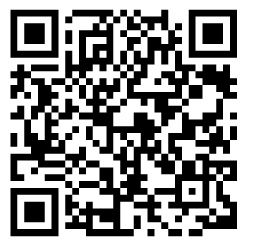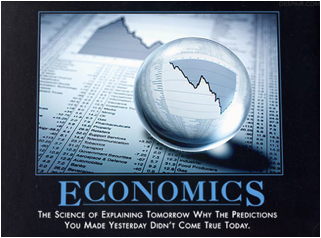This week, WhatTheyThink published our latest graphic communications industry forecast report, cleverly titled Print and Creative Forecast 2010, a look back at the year that was and, naturally, a look ahead at the year that will be. I worked on it with Dr. Joe Webb, whose Economic and Research Center data provided good chart-fodder for our quantitative analysis and forecast.
This is the tenth annual forecast I have worked on, and every year at this time I am reminded of twin quotes:
- “The only function of economic forecasting is to make astrology look respectable,” John Kenneth Galbraith, and
- “It’s tough to make predictions, especially about the future,” Yogi Berra.
Whichever one makes you chuckle more could perhaps be some kind of personality test, like “who’s your favorite Beatle” or those ridiculous quizzes that propagate virally on Facebook like H1N1.
Just for fun, I dug back into my archives to the very first forecast report Dr. Joe and I collaborated on for the company formerly called T-----h, written in late 2000 and titled—perhaps numeranagrammatically—Printing Forecast 2001 (it was only a couple of years later we added a creative forecast). Some excerpts of what we told graphic communications businesses to watch out for in 2001 included:
- The robust economy and technological change are changing the printing business from having many small businesses and a few large ones to a business dominated by mid-size and large printing organizations.
- The Internet is not stealing ad dollars. It’s stealing product information, support, and transaction dollars from print. The print industry trifecta: fewer commercial print jobs, lower page counts, longer reprint cycles. Place your bets now!
- Cross media will become ever-more important, and not just in a Web/print dichotomy. Even newer media raise significant problems, or provide significant opportunities. PDAs, E-books, cell phones—each is a new medium and a potential information delivery source. As information is needed faster and more portably, publishing to these new media will become crucial.
- Print magazines are not going away, but ad pages will continue to decline. Trade pubs will be hardest hit, as technology news can increasingly be found up to the minute online.
- E-books will be a hot topic, but more as a theoretical concept than as a practical one. Alliances between software vendors, online booksellers, and traditional book publishers will continue to be news.
Hmm...sounds like we were spot on, and those bullets pretty much sum up the majority of the past decade, although I think that was actually the last time anyone used the term “robust economy.”
So what do graphic communications businesses have to look forward to (or perhaps dread) in 2010? Well, we’re not going to give away the whole store here (the report is designed to give the complete lowdown), but I do want to highlight a few of my pet trends that creative businesses will have to contend with—or, better yet, embrace—in the coming year.
“TGIF”
The rallying cry for the past two years has been “TGIF!” and I don’t refer to the 2-for-1s at Irish Times. Rather, “Twitter, Google, the Internet, and Facebook.” If you want an idea of how fast things change, note that the Big Three topics in media and marketing today—Twitter, YouTube, and Facebook—didn’t exist more than five years ago. (Twitter was launched in 2006, YouTube in 2005, and Facebook in 2004.) And now that’s all anyone ever talks about. According to Pew Research, 19% of online Americans are on Twitter, and 46% of online Americans are on a social network like Facebook. (Given the frequency with which old high school classmates crop up on it makes me wonder if Facebook is actually underwritten by the American Psychiatric Association, but I digress.) Facebook itself says that it has more than 300 million active users. If Facebook were a country, it would be the fourth most populous in the world, falling between the United States (307.9 million) and Indonesia (231.4 million). Let’s hope they never demand their sovereignty, or that we ever have to send in inspectors looking for weapons of mass distraction.
There are two prongs to the issue of creative businesses and social media: being active on these sites oneself , and being able to help clients take advantage of these channels. Twitter, Facebook, and the business-oriented social-networking site LinkedIn are not only increasingly important ways to build virtual peer groups, but also to connect with potential clients. Tweeting and posting Facebook updates may seem like tedious chores and a time toilet, but being active on these sites is becoming almost as important as having a Web site in general or even a business card—two things that also take time...and money. So, hey, at least Twitter is free.
It bears mentioning that none of these things are really all that new. In fact, in principle, they’re all rather old. Take Twitter (please!). “Tweets” are not appreciably different from the sorts of short messages that have long been a hallmark of the back page of alternative newspapers like, say, the Village Voice, which in turn derive from the old newspaper “agony” columns (or even personal ads), which often involved personal or coded messages placed by newspaper readers for other readers. Fans of Sherlock Holmes know that the great detective occasionally used these Victorian-era proto-tweets as clues to solve cases (see, for example, The Valley of Fear or “The Adventure of the Red Circle”). And Facebook is rather similar, and is not a million miles removed from basic human networking in general. Instead of clustering in an ancient Greek agora, or down the pub, or wherever, people are getting together online. And YouTube is simply a modern version of trotting out those home movies shot with an old Super8 camera and inflicted on visiting relatives.
All of these things are simply much cheaper and easier to do now, and can be done right from one’s computer. Human behavior and the need and desire to communicate don’t change, but the logistics of that communication do change.
Mobile
Note above that back in 2000 we said “PDAs, E-books, cell phones—each is a new medium and a potential information delivery source.” We certainly called that one; smartphones like my adored iPhone, the BlackBerry, the Pre, etc., represent the continued merging of computer, PDA, and cell phone. At the same time, the proliferation and vast popularity of iPhone apps are changing the way that people interact with their environment. So called “m-commerce” (buying things via mobile phone) has yet to take off, but expect that to happen very soon. Starbucks, Dunkin Donuts, Pizza Hut, and other big food chains have branded apps that facilitate buying their stuff. But since you can access just about any e-commerce site via one’s smartphone, you don’t even need an app for that.
Mobile is an important discussion—not only because it means that the Internet now has the portability of print—buy also because it’s an important advertising and marketing channel. Not display ads, of course; I expect the display ad to be an endangered species, as users increasingly find ways to avoid ads, especially as they become more intrusive and obnoxious (one of the myriad reasons I no longer watch television is thanks to those loathsome promos they overlay on top of programming, which makes the TV-watching experience even more unbearable). Rather, marketers are using smartphone applications and computer “widgets” to create marketing tools that provide some sort of value and use for the customer, and are not just intrusive and annoying. (This also is nothing new, attested to by: my pen caddy full of pens bearing the logos of Westin, Hilton, The Journeyman Press, Nexpo, Toastmasters District 53 Fall 2008 Conference, etc.; the pen “caddy” itself which is a coffee mug that says PhotoSpin.com; the coffee mug I am drinking from now that sports the UPS logo, a gift from my local UPS Store; a pica ruler from the B&W Press in Georgetown, MA; and a calculator emblazoned with the logo of Vermillion, a printing company. Useful objects all, “analog” versions of widgets and iPhone apps.)
We’ve passed the point where users are willing to endure intrusive advertising any longer. As Bob Garfield said in his book The Chaos Scenario, discussed at length in this space, the tacit contract between audience and advertiser whereby the viewer accepts advertising as the price one pays for content has been abrogated.
Crowd Sourcing
Marketers, advertisers, and publishers are increasingly turning to the “wisdom” of crowds to do for little or no pay what high-priced agencies or other content creators used to do. User-generated advertising has been a big deal, playing on the twin notions that a) people will do anything for their fifteen minutes of fame and, b) that when they care deeply and passionately about a given product or service, they will devote a great deal of their own time and expense to promoting it.
At the same time, sites such as crowdSPRING.com, a type of graphic design auction house where people in the market for graphic design work post the specs of a job and how much they are willing to pay, are not without their controversy. Not everyone is a fan of this “commoditization” of design—as if it hasn’t been happening for more than a decade as it is. After all, anyone can create a document in Microsoft Word, use as many obnoxious fonts as possible, throw in some cheesy clip art, and call it “graphic design.” Professional designers may cringe, but all that Comic Sans is a harbinger of things to come: as more people get used to seeing “desktop design,” the more they will be inured to it and the less demand there will be for professional design. This is not new; these seeds were sown in 1985 with the advent of desktop publishing, and these same complaints were voiced at the time, to no avail.
When talking to print providers, we often stress that they need to communicate to potential customers the value of print. Likewise, it will increasingly behoove any content creator to focus on why a professional (read: more expensive) option is preferable to something that is free or dirt cheap. Anything of quality now requires a value proposition to get people to move from free to fee. What is that value proposition? Something very simple: it will help the client achieve their own goals more effectively. And this will then need to be demonstrated in some fashion.
AR/QR
Just starting to appear on people’s radar are the “two Rs”: Quick Response (QR) codes and Augmented Reality (AR). QR codes are a kind of bar code that is readable by a Webcam or mobile phone camera. If you aim your, say, iPhone camera at one and launch an iPhone app, the smartphone’s Web browser will be automatically directed to a Web site, or a YouTube video will be launched, or....you name it. It’s a quickie way of sending people to a site without having them laboriously type it in.
Here’s an example of a QE code I often use:

WhatTheyThink’s Gail Nickel-Kailing has also been experimenting with QR codes:

But there’s more to QR than just directing people places; Adam Dewitz had an interesting link a couple days on Digital Nirvana to a Palo Alto Research Center blog post about mobile printing and QR codes:
Currently, about 20 U.S. airports enable passengers to check in through a “mobile boarding pass.” These airports use special scanners to read the 2D barcodes displayed by diverse mobile manufacturers’ hardware.
We realized a similar technique could be used to “acquaint” a mobile phone and a printer, so that someone could easily print something from their phone wherever they are and whenever it’s needed (e.g., instructions, maps, notes, product information to leave behind for a prospective client).
To print from your phone, you first have to make the phone and printer “talk” to each other—which isn’t always easy. I don’t know how many times I’ve had to re-register my Bluetooth- or wifi-enabled mouse with my laptop; the irony is that they’re sitting right next to each other!
A “mobile boarding pass.” Uh huh. Knowing the airline industry, I wonder how long before they stick a fee on it. Anyway, frequent blog commenter Michael J had this comment:
Good post to highlight the non marketing uses of QR. I noticed recently that Duplo “has been using 2d codes extensively” in their digital finishing solutions. And in the last month or so every large organization bulk mailings have a 2d code in the indicia. I know it’s not consumer facing, so I have to believe it’s for process control.
The under appreciated value of 2d codes is that of emitting process information. In my opinion, the marketing buzz is mostly that—marketing buzz. But emitting process data without slowing down the process is a huge deal.
For a newspaper it means metrics for advertisers. For education it means real time data for who has clicked on the assignment and who hasn’t. For the health business it can help give doctors they need to monitor compliance directly from the drugs packaging. For every enterprise, it provides a trail and a record for compliance.
Hmm...wasn’t this supposed to be what RFID was supposed to do? Score one for print!
At the same time, so-called augmented reality uses printed codes or tags in the physical environment to launch electronic applications on a computer or mobile phone and has the potential to make print “the ultimate in interactive media.” More than that, though, it can take advantage of the GPS capabilities of the latest generation of smartphones to overlay information over the view through the phone’s camera. Apps like RobotVision, to name one, are still in their infancy, but AR has the potential to further change the way that smartphone users interact with their environment.
And, Um, Oh, Yeah...That
What about the economy? Well, there are some glimmers of hope, and the sense we get is that everyone is simply waiting for a change of calendar, but we will likely remain—for a time anyway—at what Dr. Joe calls “the bumpy bottom.” Unemployment will likely remain high for the foreseeable future, which may be good news for freelancers. (On the other hand, it means there is more competition.)
But then, whenever I think about economics forecasting, I am reminded not only of the Galbraith quote cited earlier, but also one of my favorite “Demotivators” from Despair.com:

Still, as we always advise in the face of a dire economic climate, smart businesses and individuals don’t cower in fear at the prospect of bad times, but seek ways to expand their capabilities and think more strategically about what it is they do and whom they do it for. It’s often a good idea to turn off cable news (well, okay, it’s always a good idea) and just get on with it.
Ultimately, don’t expect a return to normal; there is no “normal” to return to. In fact, there never was.
The Creative Corner will be on hiatus next week for the Thanksgiving holiday, but will return on December 3 with a roundup of graphic design plug-ins and other utilities. Join us then—and have a great holiday!














